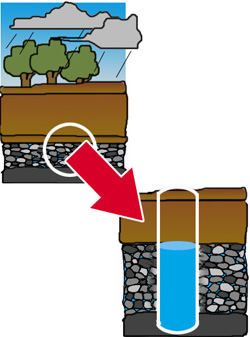Aquifers

Think back to the rocks you experimented with in the warm-up activity of this section. Some rocks can absorb water because they have lots of open spaces in them, like the pumice. Layers of rock or sand and gravel that hold water are called aquifers. Aquifers exist because some rocks can absorb and hold water. In the diagram, you see how all the tiny pore spaces within the grey rock layer can add up to a significant amount of water. The aquifer is the collection part of a groundwater system.
Do all rocks serve equally well as aquifers?
No. As you probably saw in the warm-up activity, the pumice absorbed more water than your average backyard rock, because the pumice has so many pores, or open spaces in it. To be a useful aquifer, the rock layer must be one from which water can be easily extracted for human use. Some rocks have too few pore spaces and do not hold water as well as other rock layers. Depending on the type of rocks under them, some parts of the world have better supplied aquifers than others.
Can you think of another object that can hold water like an aquifer?
A sponge can hold water like an aquifer.